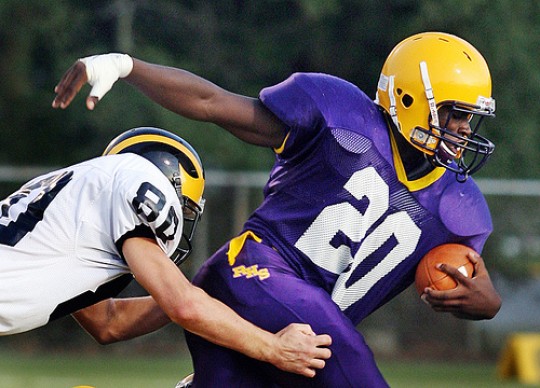Study suggests football-related concussions caused by series of hits, not a single blow.
Study suggests football-related concussions caused by series of hits, not a single blow
Football-related concussions may be caused by series of hits to the head over time rather than a single blow, according to findings from a two-year study of high school athletes.

In a study slated to be published in theJournal of Biomechanics, Purdue University researchers assigned high school football players to wear special helmets equipped with sensors capable of measuring the number and severity of head impacts. Researchers also scanned participants’ brains using functional magnetic resonance imaging (fMRI) while they took cognitive tests. Shots reports:
Then they compared the brain scans with the hits. Those hits weren’t rare. Each player logged from 200 to more than 1,800 hits to the head in a single season. Over two seasons, six players had concussions, but 17 others showed brain changes even though they didn’t have concussions. There were 21 players in the first season, and 24 in the second, 16 of whom were repeat participants in the study.
Over time, the changes in brain function that showed up in the MRIs correlated to the number and distribution of hits. Mental performance didn’t change, but brain activity did.
…
Those brain changes may be workarounds, with the brain using other areas to replace those affected by the hits, according to Thomas Talavage, an associate professor of electrical and computer engineering at Purdue University and a co-author of the study.
Researchers say the findings support the theory that a concussion comes as the result of a succession of hits, not just one all-powerful hit. Still, more research is needed to confirm this belief. As a result, the current study has been expanded to include two other football teams and a girls’ soccer team. In addition, researchers are following football players in the initial study who had the highest hit tally to determine if the brain changes are permanent.
Similarly, Stanford researchers launched a study last fall where university football players were outfitted with mouthpieces containing high-tech sensors to better understand the biomechanics of brain injuries.
By Lia Steakley
Stanford University Medical Center
Photo by Mitch Loeber
###
* Stanford University Medical Center integrates research, medical education and patient care at its three institutions – Stanford University School of Medicine, Stanford Hospital & Clinics and Lucile Packard Children’s Hospital.
** The above story is adapted from materials provided by Stanford University School of Medicine
________________________________________________________________




















